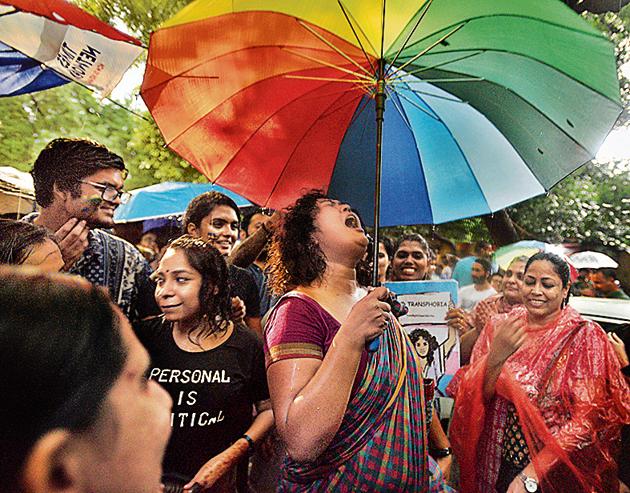Sec 377 judgment: An atonement for a grievous error, but a gateway towards greater freedom
It acknowledged that in a society as diverse as ours, tolerance for different forms of life, and acceptance of different ways of being, are the warp and the weft of the fabric of our plural culture.
Nine years ago, in their judgment decriminalising homosexuality (Naz Foundation v NCT of Delhi), Chief Justice AP Shah and Justice S Muralidhar of the Delhi High Court introduced the idea of “constitutional morality” into our everyday lexicon. The defenders of Section 377 had invoked public distaste and opprobrium to justify its retention in the statute books. Rejecting this argument, the justices observed that “if there is one constitutional tenet that can be said to be underlying theme of the Indian Constitution, it is that of ‘inclusiveness’. This Court believes that Indian Constitution reflects this value deeply ingrained in Indian society, nurtured over several generations.”

At the dawn of Independence, Jawaharlal Nehru recalled how, during the freedom struggle, our nation had passed through the “valley of shadow” — and, if necessary, we would pass through it again. In 2013, the Supreme Court plunged the LGBT+ community into another valley of shadow, when it overturned Naz Foundation, and observed that “the so-called rights of the minuscule minority” could not become grounds for challenging a law.
But on September 6, the wheel turned full circle. In Navtej Johar v Union of India, a Constitution Bench of our Supreme Court resurrected Naz Foundation, decriminalised same-sex relations (once again), and affirmed that the LGBT+ community was entitled to equal rights under our Constitution. At the heart of the Supreme Court’s judgment was the idea of constitutional morality, that was finally given its due, almost a decade after it was first articulated in a courtroom. In the words of the Chief Justice, “Any attempt to push and shove a homogeneous, uniform, consistent and a standardised philosophy throughout the society would violate the principle of constitutional morality. Devotion and fidelity to constitutional morality must not be equated with the popular sentiment prevalent at a particular point of time.”
Like the Delhi High Court did in 2009, the Supreme Court spoke the language of inclusiveness. It acknowledged that in a society as diverse as ours, tolerance for different forms of life, and acceptance of different ways of being, are the warp and the weft of the fabric of our plural culture. To some of us, embedded in our own social and cultural milieus, some of these ways of being may be strange at first, and even frightening. But our Constitution is the bridge that allows us to meet each other above the abyss of prejudice and intolerance. The building blocks of that bridge are Article 14 (equal protection of laws), Article 15 (non-discrimination), Article 19(1)(a) (freedom of expression), and Article 21 (life and personal liberty). And its foundation is the concept of fraternity, which is at the heart of our Constitution’s Preamble. Fraternity, in the words of Justice DY Chandrachud, “envisaged a transformation in the order of relations not just between the state and the individual, but also between individuals: in a constitutional order characterised by the Rule of Law, the constitutional commitment to egalitarianism and an anti-discriminatory ethos permeates and infuses these relations.”
And it was, indeed, a transformation. It is no surprise that Section 377 was part of the Indian Penal Code of 1860, a brutal law imposed upon us by an alien, colonial regime, exemplifying alien cultural values. It was part of an entire web of laws that treated segments of society as inferior (the Criminal Tribes Act), trapped within communitarian diktats (regimes of “personal law”), incapable of exercising freedom (censorship laws), and so on. And this was a regime that was maintained by force and coercion.
But for decades, Indians protested, mobilised, organised, and campaigned against this regime. And in doing so, they articulated a grammar and a language of personal liberty, of substantive equality, and of fraternity; a grammar and a language opposed to the rule of force, the establishment of hierarchies (on grounds of caste, gender, etc.), and the walls that separated people from their fellow human beings. This was the meaning of the Indian freedom struggle, and this was what culminated in the drafting of independent India’s Constitution. Our Constitution was — and is — meant to transform both the relationship between the individual and the State, and between individuals and individuals, in the direction of liberty, equality, and fraternity. This was what the Delhi High Court meant when it placed “inclusiveness” at the heart of the transformative constitutional order.
And it was this that the Supreme Court reclaimed last week. Navtej Johar is not only an atonement for a grievous error, but a gateway towards greater freedom.
Gautam Bhatia is one of the lawyers who represented Voices Against 377, a coalition of organisations which challenged Section 377 before the Court
The views expressed are personal






